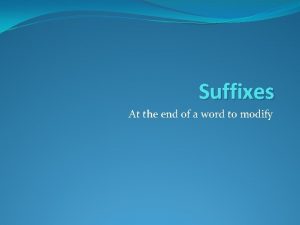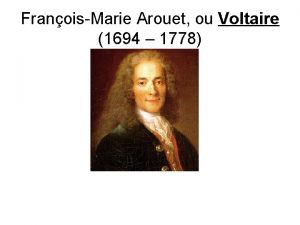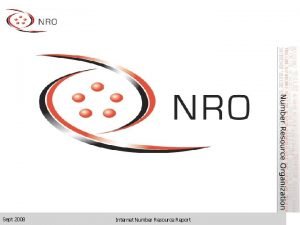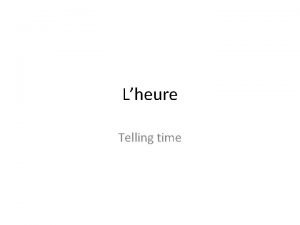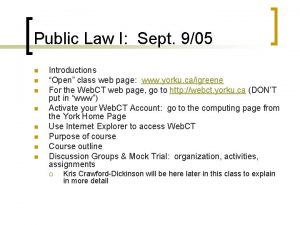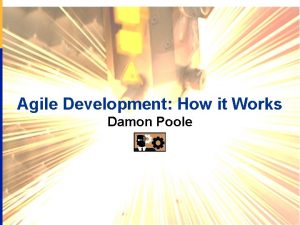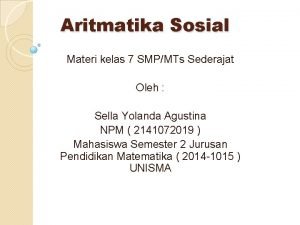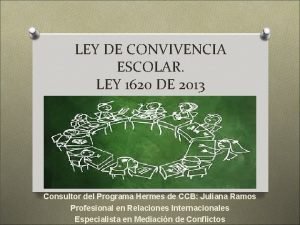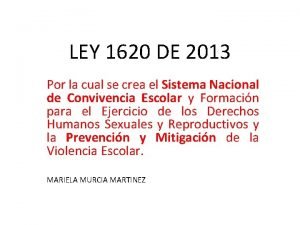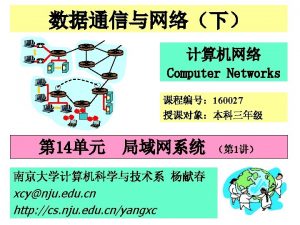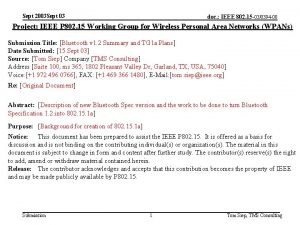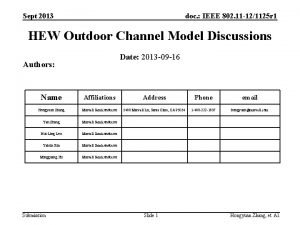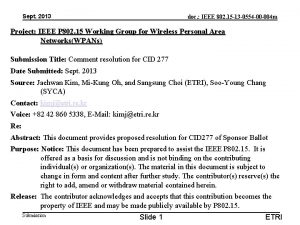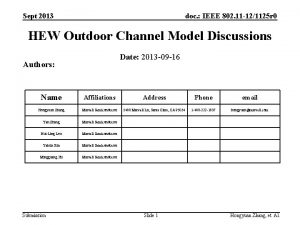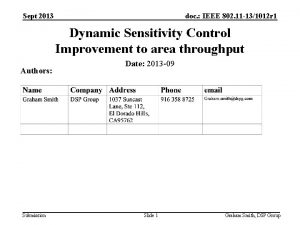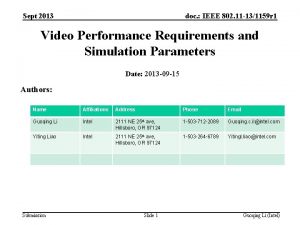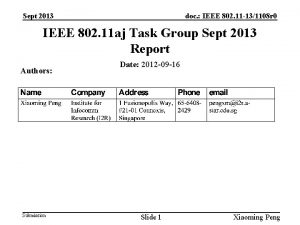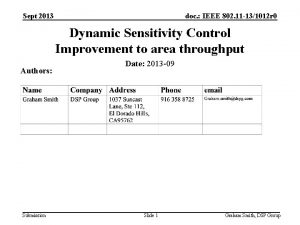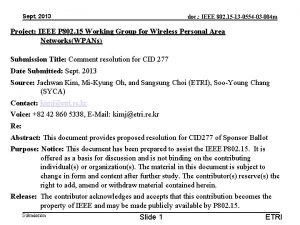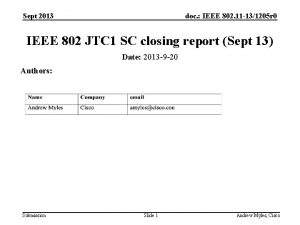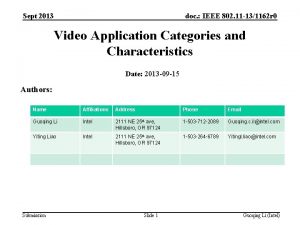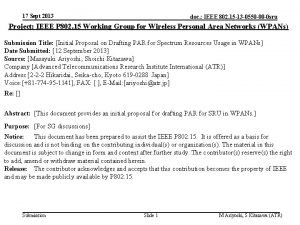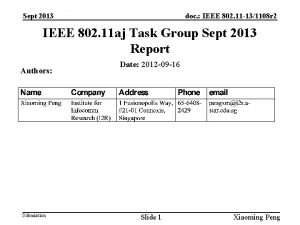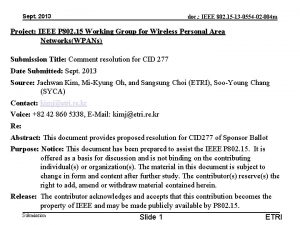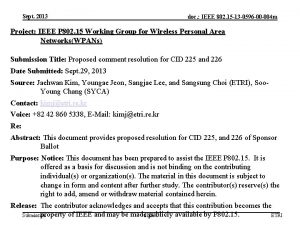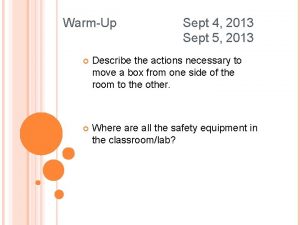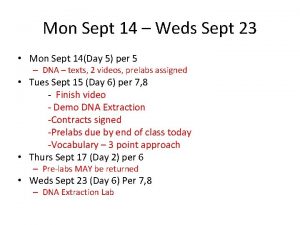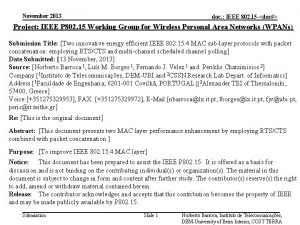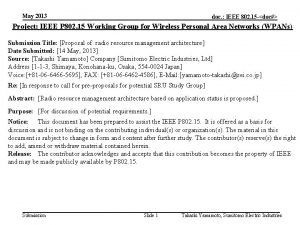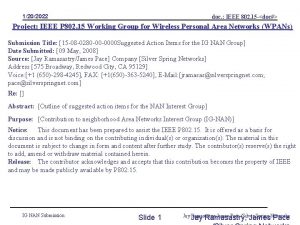Sept 2013 doc IEEE 802 11 131032 r




























- Slides: 28

Sept 2013 doc. : IEEE 802. 11 -13/1032 r 0 Video Applications Characteristics, Requirements and Simulation modeling Date: 2013 -08 -19 Authors: Name Affiliations Address Phone Email Guoqing Li Intel 2111 NE 25 th ave, Hillsboro, OR 97124 1 -503 -712 -2089 Guoqing. c. il@intel. com Yiting Liao Intel 2111 NE 25 th ave, Hillsboro, OR 97124 1 -503 -264 -6789 Yitingl. liao@intel. com Submission Slide 1 Guoqing Li (Intel)

Sept 2013 doc. : IEEE 802. 11 -13/1032 r 0 Outline • Video traffic growth and Qo. E today • What are the characteristics of video applications? • How to measure video performance in HEW? • How to model video traffic in HEW simulation? Submission Slide 2 Guoqing Li (Intel)

Sept 2013 doc. : IEEE 802. 11 -13/1032 r 0 Video Traffic Growth • In 2017, 73% of global IP traffic will be video It is difficult to overstate the importance of video traffic demand for HEW networks Submission Slide 3

Sept 2013 doc. : IEEE 802. 11 -13/1032 r 0 Poor Video Quality of Experience is Pervasive • In 2012, global premium content brands lost $2. 16 billion of revenue due to poor quality video streams and are expected to miss out an astounding $20 billion through 2017 [1] • The rapid video traffic growth will only make the problem worse, if not addressed properly Future wireless networks including HEW have to deliver satisfying video Qo. E in order to meet future demands 4 Submission Wireless Copyright@2012, Communication Intel Corporation. Lab, Intel Labs All rights reserved. Slide 4 Guoqing Li (Intel) Intel Labs Intel Confidential

Sept 2013 doc. : IEEE 802. 11 -13/1032 r 0 Outline • Video traffic growth and Qo. E today • What are the characteristics of video applications? • How to measure video performance in HEW? • How to model video traffic in HEW simulation? Submission Slide 5 Guoqing Li (Intel)

Sept 2013 doc. : IEEE 802. 11 -13/1032 r 0 Video Applications Considered 1. Buffered video streaming 2. Video Conferencing 3. Wireless display STB Submission Slide 6 Guoqing Li (Intel)

doc. : IEEE 802. 11 -13/1032 r 0 Sept 2013 1. Buffered Video Streaming Video service, encoding, transcoder etc. Network Transport IP IP network wireless access 7 Submission Wireless Copyright@2012, Communication Intel Corporation. Lab, Intel Labs All rights reserved. Guoqing Li (Intel) Intel Labs Intel Confidential

Sept 2013 doc. : IEEE 802. 11 -13/1032 r 0 1. Buffered Video Streaming (cont. ) • Video data one way traffic, high asymmetrical at wireless • Multi-hop, multi-network domain • Uses buffer at the client side to store a few seconds to a few minute of video before playout – High dependency on client playout buffer and policy capabilities • Typical traffics are natural videos including movies, news etc. • Typical Protocol stack: HTTP (TCP) – Provides additional reliability 8 Submission Slide 8 Wireless Copyright@2012, Communication Intel Corporation. Lab, Intel Labs All rights reserved. Guoqing Li (Intel) Intel Labs Intel Confidential

Sept 2013 doc. : IEEE 802. 11 -13/1032 r 0 2. Video Conferencing • Two-way traffic • Multi-hop, multi-network domain • Typically traffics: natural video, but more static scenes – Less traffic load compared to video streaming • Typical protocol: UDP/IP – May require lower packet loss ratio at MAC since UDP does not provide additional reliability 9 Submission Slide 9 Wireless Copyright@2012, Communication Intel Corporation. Lab, Intel Labs All rights reserved. Guoqing Li (Intel) Intel Labs Intel Confidential

Sept 2013 doc. : IEEE 802. 11 -13/1032 r 0 3. Wireless Display Entertainment wireless display • Movie, pictures • Relaxed viewing experience • Far distance ~10 feet Wireless docking • Synthetic video: Text, Graphics • Long static scenes • Highly attentive • Close distance ~2 feet • High interactive 10 Submission Slide 10 Wireless Copyright@2012, Communication Intel Corporation. Lab, Intel Labs All rights reserved. Guoqing Li (Intel) Intel Labs Intel Confidential

Sept 2013 doc. : IEEE 802. 11 -13/1032 r 0 3. Wireless Display (cont. ) • One way traffic, one hop, single network domain • High resolutions, fine images, high user engagement Requires very high video quality, visually lossless • Human interaction, hand-eye coordination involved – Requires ultra low latency 11 Submission Slide 11 Wireless Copyright@2012, Communication Intel Corporation. Lab, Intel Labs All rights reserved. Guoqing Li (Intel) Intel Labs Intel Confidential

Sept 2013 doc. : IEEE 802. 11 -13/1032 r 0 Characteristics of Various Video Applications app Typical content network resolution User engagement interactivity Buffered Streaming Natural video Multi-hop, multiple network domain Small, large Relaxed No Video conferencing Natural video Multi-hop, multiple network domain, Small, large Relaxed Yes Wireless displayentertainment Natural video Single-hop large Relaxed No Single-hop large Intense attention Yes Wireless display-- Desktop docking video Performance requirements can be very different for different type of video applications 12 Submission Slide 12 Wireless Copyright@2012, Communication Intel Corporation. Lab, Intel Labs All rights reserved. Guoqing Li (Intel) Intel Labs Intel Confidential

Sept 2013 doc. : IEEE 802. 11 -13/1032 r 0 Video Bit Rate Variation • Compressed bit rate is highly related to – Video format: resolution, frame rate, progress/interlaced – Coding parameters, e. g. , I-only, I+P+B – Video Content itself • Different type of video applications may have very different video format, coding parameters and content characteristics • There, video traffic modeling needs to treat different video applications differently Bit rate (Mbps) 400 350 300 250 200 150 100 50 0 codec profile 1 codec profile 2 Seq. 1 13 Seq. 2 Seq. 3 Seq. 4 video sequence Submission Slide 13 Wireless Copyright@2012, Communication Intel Corporation. Lab, Intel Labs All rights reserved. Seq. 5 Guoqing Li (Intel) Intel Labs Intel Confidential

Sept 2013 doc. : IEEE 802. 11 -13/1032 r 0 Outline • Video traffic growth and Qo. E today • What are the characteristics of video applications? • How to measure video performance in HEW? • How to model video traffic in HEW simulations? Submission Slide 14 Guoqing Li (Intel)

Sept 2013 doc. : IEEE 802. 11 -13/1032 r 0 Video Quality/Experience Metrics • Video quality – Subjective, objective – Mostly related to distortion against original video pixels • Video experience – Video start time, re-buffering event, latency, bit rate, packet loss rate – Mostly related to network capacity, Qo. S provisioning along the path and device capabilities 15 Submission Slide 15 Wireless Copyright@2012, Communication Intel Corporation. Lab, Intel Labs All rights reserved. Guoqing Li (Intel) Intel Labs Intel Confidential

Sept 2013 doc. : IEEE 802. 11 -13/1032 r 0 Video Quality Metrics • Subjective scores (MOS): human-involvement • Objective metrics – Reference-based: PSNR, SSIM, MS-SSIM • Not accurately reflection of user experience • Need to calculate the metrics based on pixels – Non-reference based: P 1202 (ITU) Source: Intel IDF 2012 14 video clips, 96 compressed bit streams 16 Submission Slide 16 Wireless Copyright@2012, Communication Intel Corporation. Lab, Intel Labs All rights reserved. Same PSNR can correspond to MOS from Guoqing Li (Intel) Intel Labs 1. 3 (Bad) to 4. 6 (excellent)Intel Confidential

Sept 2013 doc. : IEEE 802. 11 -13/1032 r 0 Video Quality Metrics (cont. ) • The video layer quality metrics deal with either – Human testing – Pixels-level calculation (e. g. , PSNR, MS-SSIM) – Analysis of compressed bit stream (e. g, P 1202. 1) • These video quality metrics are NOT suited for HEW evaluation methodology 17 Submission Slide 17 Wireless Copyright@2012, Communication Intel Corporation. Lab, Intel Labs All rights reserved. Guoqing Li (Intel) Intel Labs Intel Confidential

Sept 2013 doc. : IEEE 802. 11 -13/1032 r 0 Video Experience Metrics • Buffering has the largest impact on video streaming experience [1]! • Rubuffering event = playout buffer is empty when it is time to display the next packet/video unit • Rebuffering ratio =percentage of time that the video is being rebuffered during the entire viewing duration • Because a big buffer typically exists at receiver for smoothing out large delay and jitter, individual packet delay does not directly impact video experience Instead, E 2 E throughput against video load has more impact on rebufferiing 0. 5%--1% rebuffering ratio is considered above industry-average [1] • • 18 Submission Slide 18 Wireless Copyright@2012, Communication Intel Corporation. Lab, Intel Labs All rights reserved. Guoqing Li (Intel) Intel Labs Intel Confidential

Sept 2013 doc. : IEEE 802. 11 -13/1032 r 0 Video Experience Metrics (cont. ) • Similar to rebuffering, Freezing happens in video conferencing and wireless display – Caused when the receiver buffer is empty when it is time to display the next packet/video unit 19 • Unlike buffered steaming, there is no big buffer at RX due to low latency requirement, and thus not able to absorb large individual packet latency • As a result, each packet needs to arrive in time in order to be display at the right time, which means Latency for every packet matters • Freezing event happens when E 2 E latency for video frames/slices exceed some E 2 E latency requirement • Freezing ratio = percentage of time the video freezes during the entire video conferencing • 0. 5 -1% freezing ratio is recommended based on number used in buffered streaming? Submission Wireless Copyright@2012, Communication Intel Corporation. Lab, Intel Labs All rights reserved. Slide 19 Intel Labs Intel Confidential

Sept 2013 doc. : IEEE 802. 11 -13/1032 r 0 Video Experience Metrics (cont. ) • E 2 E Latency – Buffered Streaming video: [2] recommends 5 s for initial delay, but no hard requirement on each packet • As long as video can be downloaded before playout buffer is empty, the system can tolerate large delay variations – Wireless display • Home: recommend 50 ms based on the requirement for the interactive gaming application in [3] • Office: recommend 20 ms based on wireless display requirement in [5] – Video conferencing: 150 ms is recommended [2] • What is the latency requirement for the HEW portion? 20 Submission Slide 20 Wireless Copyright@2012, Communication Intel Corporation. Lab, Intel Labs All rights reserved. Guoqing Li (Intel) Intel Labs Intel Confidential

Sept 2013 doc. : IEEE 802. 11 -13/1032 r 0 Video Experience Metrics (cont. ) • HEW latency – For Video conferencing: derived from E 2 E latency • IP network latency varies significantly in regions Ø E. g. , <45 ms within North America, <90 ms between London-N Y[15] • HEW latency for video conference: (150 ms-X)/2 – Buffer streaming: no requirement on each packet – Wireless display: same as E 2 E latency since it is one-hop 21 Submission Slide 21 Wireless Copyright@2012, Communication Intel Corporation. Lab, Intel Labs All rights reserved. Guoqing Li (Intel) Intel Labs Intel Confidential

Sept 2013 doc. : IEEE 802. 11 -13/1032 r 0 Video Experience Metrics (cont. ) • Even though bit rate can vary significantly for different video applications and different contents, some empirical data exists that we can consider for video bit rate requirement and traffic modeling • Video bit rate—based on resolutions used today – For video streaming: 5 -8 Mbps is recommended for HD [10][11] – For video conf: 0. 5 Mbps-2. 5 Mbps for HD calling [7][8] – For wireless display • Office: recommend 300 Mbps@1080 p (compression ratio = 10) to achieve visually lossless [9] • Home (Entertainment): 60 Mbps? Ø Assume I frame is 10 times bigger than P frame. Allow 2/3 of the frames to be P frame will increase the compression ratio further, we approximate this ratio as 50, which leads to 60 Mbps • Future video bit rate will increase with the new video formats and more adoption of 3 D – E. g. , 4 K video bit rate is about 4 times higher than 1080 p, i. e. , 20 -32 Mbps 22 Slide 22 Submission Copyright@2012, Wireless Communication Intel Corporation. Lab, Intel Labs All rights reserved. Guoqing Li (Intel) Intel Labs Intel Confidential

Sept 2013 doc. : IEEE 802. 11 -13/1032 r 0 Video Experience Metrics (cont. ) • Similarly, some empirical data exists for packet loss requirement • Packet Loss requirement – For buffered streaming, mostly based on TCP • 5% (IP layer) is recommended in [2] • Note: after TCP retry, the application PER is close to 0. – For video conferencing, mostly based on UDP • 1% (IP layer) is recommended in [2] – For wireless display • Home: 1 e-3 (based on gaming app in [3]) • Office: 1 e-6 (highest requirement in [3]) 23 Submission Slide 23 Wireless Copyright@2012, Communication Intel Corporation. Lab, Intel Labs All rights reserved. Guoqing Li (Intel) Intel Labs Intel Confidential

Sept 2013 doc. : IEEE 802. 11 -13/1032 r 0 Summary of video quality metrics and requirements 24 app Packet loss E 2 E delay HEW latency Rebuffering/freez ing ratio Bit rate per HD stream Buffered Streaming 5% 5 s (no requirement) N/A 0. 5 -1% 5 -8 Mbps Video conf 1% 150 ms (E 2 E) 25 ms (assume core network latency is 100 ms) 0. 5 -1% for Prob (latency>E 2 E requirement) 0. 5 -2. 5 Mbps Wireless display -home 1 e-3 50 ms 0. 5%? 60 Mbps? Wireless display —office/gaming 1 e-6 20 ms 0. 5%? 300 Mbps Submission Slide 24 Wireless Copyright@2012, Communication Intel Corporation. Lab, Intel Labs All rights reserved. Guoqing Li (Intel) Intel Labs Intel Confidential

Sept 2013 doc. : IEEE 802. 11 -13/1032 r 0 Outline • Video traffic today and tomorrow • What are the characteristics of video applications? • How to measure video performance in HEW? • How to model video traffic in HEW simulation? Submission Slide 25 Guoqing Li (Intel)

Sept 2013 doc. : IEEE 802. 11 -13/1032 r 0 Video Traffic Modeling • [12] gives some details regarding video traffic model, but it did not suggest the average video bit rate • We suggest to set the average bit rate as follows for different video applications: – – 26 Buffered video: 6 Mbps Video Conf: 1. 5 Mbps Wireless display at home: 60 Mbps Wireless display in enterprise: 300 Mbps Submission Slide 26 Wireless Copyright@2012, Communication Intel Corporation. Lab, Intel Labs All rights reserved. Guoqing Li (Intel) Intel Labs Intel Confidential

Sept 2013 doc. : IEEE 802. 11 -13/1032 r 0 Summary • Video applications will consume the majority of future traffic. However, user are not satisfied with the Qo. E today • Therefore, it is critical for HEW to deliver satisfying Qo. E for video in order to meet such future demand • There are different types of video applications today, and they have very different characteristics • As a result, performance requirements as well as video simulation modeling should be set accordingly for different applications – On performance requirements: we recommend buffer/freezing ratio, latency, packet loss as performance metrics for HEW evaluation instead of video layer metrics – On simulation modeling: we recommend different bit rates for different video applications 27 Submission Slide 27 Wireless Copyright@2012, Communication Intel Corporation. Lab, Intel Labs All rights reserved. Guoqing Li (Intel) Intel Labs Intel Confidential

Sept 2013 doc. : IEEE 802. 11 -13/1032 r 0 References • • • • 28 [1] Conviva, H 1 2013 Viewer Experience report [2] Cisco report, Quality of service design overview [3] 3 GPP 23. 203, Technical Specification Group services and System aspects; policy and charging control architecture [4] ITU-T Y. 1542, Framework to achieve E 2 E performance [5] Wi. Gig Display Market Requirement Document 1. 0 [6] 11 -13 -0787 -00 -0 hew-followup-on-functional-requirements [7] Lync report, network bandwidth requirement for multimedia traffic [8] Skype report, how much bandwidth does Skype need [9] Wi. Gig contribution, H. 264 intra quality evaluation [10] Netflex article, Internet connection recommendation [11] Youtube article, advanced encoding setting [12] 11 -13 -0722 -00 -0 hew-evaluation-methodology [13] Cisco Visual Networking Index: Forecast and Methodology, 2012– 2017 [14] Baek-Young Choi et al. , Analysis of Point-to-point packet delay in an operatorational network, Infocom 2004 [15] Verizon report, IP latency Statistics 2012 -2013 [16] Cisco white paper, The Zettabyte Era—Trends and Analysis Submission Slide 28 Wireless Copyright@2012, Communication Intel Corporation. Lab, Intel Labs All rights reserved. Guoqing Li (Intel) Intel Labs Intel Confidential
 Bridges from 802.x to 802.y
Bridges from 802.x to 802.y Bridges from 802.x to 802.y
Bridges from 802.x to 802.y Ieee802.22
Ieee802.22 Arquitetura ieee 802
Arquitetura ieee 802 Estandares ieee 802
Estandares ieee 802 Ieee 802 standard
Ieee 802 standard 802 15
802 15 802 ieee
802 ieee Ieee 802
Ieee 802 Ieee 802 family
Ieee 802 family Ieee 802 3 compliance
Ieee 802 3 compliance Deportes
Deportes Sept comme setteur questionnaire
Sept comme setteur questionnaire Sept commandements
Sept commandements Sept prefix words
Sept prefix words Candide ou l optimisme
Candide ou l optimisme Cnn 10 4/5
Cnn 10 4/5 Sept
Sept Dessin poésie le blaireau sans gêne
Dessin poésie le blaireau sans gêne Is jerusalem built on seven hills
Is jerusalem built on seven hills Sept heure moins le quart
Sept heure moins le quart Un deux trois quatre cinq six sept
Un deux trois quatre cinq six sept I sept
I sept Ecrivez les sept jours de la semaine
Ecrivez les sept jours de la semaine Damon poole
Damon poole Modul aritmatika sosial kelas 7 doc
Modul aritmatika sosial kelas 7 doc Ley 1620 de 2013
Ley 1620 de 2013 Ley 1620 de 2013 situaciones tipo 1 2 y 3
Ley 1620 de 2013 situaciones tipo 1 2 y 3 802 protocols
802 protocols














